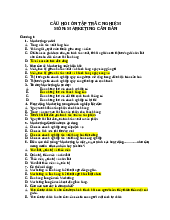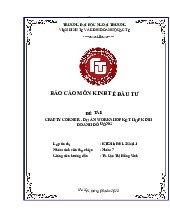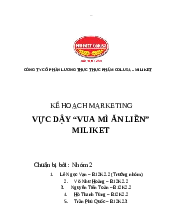








Preview text:
Portfolio Entry 1: The ‘global marketing’ concept: (Hollensen, 2012:
chapter 1) Task 1:
The Glocalization framework

Hollensen, S.( 2012) Essential of Global Marketing. Pearsons. 2nd Edition: Chapter 1, page 13
Q1. Explain the Glocalisation framework
Nowadays, many company in the world has the ambition of bringing its products to the global market, or can be mentioned as ‘globalization’, especially when their international market has been saturated (Levitt, 1983). Besides, to be able to gain the hearts of consumers in the country they export to, they also need to think about ‘localization’. Glocalization is a combination of two concepts ‘globalization’ and ‘localization’ (Mendis, 2007, p.2).
Glocalization is when a company takes its product to a foreign market, and flexibly adapts its product to that country's culture. The point of view of Glocalization was mentioned by Svend Hollensen in his book Essentials of Global Marketing in 2012 as follows: ‘think globally but act locally’ (Hollensen, 2012a, pp.12–13).
Q2. Evaluate what benefit(s) a company might achieve by adopting a
‘think globally but act locally’ strategy
The benefits of ‘think globally but act locally’ have been researched and pointed out by Keniche Ohmae, a Japanese management consultant. This result has been mentioned in the book 'Managing in the Global Economy' by two authors Richard M. Steers, Luciara Nardon. Here, the benefit of glocalization is shown that it not only helps the company to gain the benefit of economic growth when globalizing its products, but also helps the company to get satisfaction from customers through the 'localization' of those products (Steers and Nardon, 2015, pp.14–15).
By localizing those products, the company can meet the specific needs of local customers, as well as help the products fit into the local culture. This will make customers feel that this product is made for their country, their culture. Once the customer is satisfied, they will continue to buy products from that company in the future (Steers and Nardon, 2015, pp.14–15).
Q3. Find at least one example from the real business world that supports this portfolio entry. Your example should demonstrate ‘Glocalisation’.
Glocalization seems to be an effective trend when companies want to globalize their products. We can observe the Glocalization trend in some global corporations such as Coca-cola, Starbucks, Nike or McDonald's (Roudometof, 2016).
Glocalization tactics of McDonald’s will be analyzed to underpin this portfolio.
McDonald's is one of the leading companies in the fast food industry (Pizam,
2015, p.62). According to statistics from Statista, global revenue from McDonald's franchised restaurants peaked at more than $90 billion in 2019, the highest in a 15-year period since 2016 (Statista, 2021a).
In Japan, McDonald's has introduced Teriyaki McBurger on its menu (Nakamaki, Hioki and Mitsui, 2016, p.78). McDonald's has combined its famous McBurger with the Teriyaki method, a special Japanese grilling technique (Shimbo, 2000, p.77). Similarly, in New Zealand, McDonald's has launched the Beetroot Burger (Parker, 2005, p.2). In fact, in New Zealand and Australia, eating burgers with slices beetroots is quite common (Harper, Mudd and Whitfield, 2006, p.45). It seems that McDonald's, has grasped that taste and adapted its burgers to suit the local culture.
Portfolio Entry 2: Review of merging BRIC markets
Task 2:
Q1. Choose one of the emerging BRIC (Brazil, Russia, India & China) markets: using the resources like Global Edge
(http://globaledge.msu.edu/reference-desk) provide the following information.
- Provide a brief background to your chosen BRIC country
China is one of the largest and most populous countries in the world (Worldometer, n.d.). As a country located in East Asia, bordered by 14 different countries, in addition to 3 large seas , this has made China's trade develop relatively strongly. The government of China is communist, headed by the president and general secretary. China also participates in APEC and APTA. The currency of China is Yuan (Global Edge, n.d.).
- Evaluate the political risks for your chosen country
The political risks of China were pointed out by Ian Bremmer and Fareed Zakaria in the Harvard Business Review in 2016. The uncertainties in China's politics that the two authors raised include: people's unemployment; the inadequate division of land aroused the anger of the people; the gap between rich and poor is widening, etc (Bremmer and Zakaria, 2006).
In addition, tariffs are an issue that companies that want to enter the market need to pay attention to. Tariffs in China are currently at 7.6% according to the most recent data, Meanwhile, this rate in the EU is 5.1%. Foreign companies that want to enter the Chinese market also need to understand a number of relevant laws. For example: Foreign NGO Management Law for not-for-profit companies; e-Commerce Law regulates issues related to the field of ecommerce between the two countries; Foreign Investment Law creates a number of regulations to help foreign companies compete fairly with domestic companies. In addition, foreign companies also need to know more about the business areas and products in which they are allowed or not allowed to participate. These are also clearly regulated by the Chinese government in the Market Access Negative List (MANL) and the Foreign Investment Negative List (FINL) (Foreign & Commonwealth Office, 2021).
Even with those laws, companies that want to enter the Chinese market should also be careful as China tends to protect domestic companies. Alibaba's sales in China are much higher than that of Ebay or Amazon, or Uber being completely replaced by transportation service Didi. In addition, China is also very strict in limiting the rights or banning foreign technology companies from operating in the country. A common example is that Google or Facebook services are banned in this country (Salgues, 2018).
- Review the economic environment for your chosen country
China is one of the countries with the strongest economic potential in the world when its GDP ranks 2nd in the world, only after that of US (The World Bank, n.d.). Among the four BRIC countries, China has the lowest inflation rate, at 2.4%. Besides that, total exports of goods and services as well as imports of goods and services also ranked first among those four markets, at $2.72 trillion and $2.35 trillion respectively. All of these metrics are calculated in 2020 according to the Global Edge site (Global Edge, 2020).
- Summarise the advantages and disadvantages for a UK company (or a company from your domestic country) looking to move into this new market
When a UK company wants to enter the Chinese market, the first benefit it has is the large market capacity. As of 2021, the total population of China is 1.4 billion, enough to create a huge potential market (Textor, 2021). The second benefit that companies have is that foreign investment laws were passed to help foreign companies compete in the Chinese market. In addition, with the largest export and import volume in the BRIC countries, it represents the import and export potential in China for foreign countries.
Speaking of the disadvantages, or rather, the things to consider when UK companies want to enter this lucrative market, first, as mentioned above, the tariffs in China are much higher than those in EU. Secondly, UK companies need to be clear about which categories, or business areas, are allowed to operate through MANL and FINL. The third disadvantage is the strict management of social networking platforms and web browsers, leading to companies that want to penetrate here have to choose a new social networking platform to promote.
Portfolio Entry 3: Why Internationalise? (Hollensen, 2012: Chapter 2)
Task 3:
Q1. There are triggers and motives that cause companies to internationalise. Select one trigger and one motive and debate these in relation to why a company may chose to internationalise. Where possible, support your answer with potential real-business examples.
Toyota is one of the most successful car manufacturers in the world (Dicken, 2007, p.289). In the Vietnamese market, Toyota's market share in the car segment accounts for about 24.9%, nearly a quarter of the national market share (Statista, 2021b). In Japan, Toyota officially became the most successful car manufacturer in Japan in 1955. Because of its success in the domestic market, Toyota had a desire to expand into the international market. The first market that Toyota expanded to was the US market in 1957. However, it was not until 2 years later that Toyota really succeeded in this market with the Land Cruiser (Farrell, 2008, p.312). This clearly shows that the motive for Toyota to internationalize is the Managerial urge. Managerial urge is defined as the motivation expressing the desire to expand and continue to develop its market of managers (Hollensen, 2012b, p.36). This is completely true with the actions of Toyota, when they were too successful in the Japanese market and began to want to develop into the international market.
However, for internationalization to take place, motivation alone is not enough. Companies also need triggers to make this internationalization plan into action. And the trigger that pushed Toyota to bring its products abroad is market demand, an external trigger. According to Farrell (2008), the demand from overseas markets comes from Toyota's introduction of a system of guidelines and principles in car production called Toyota Production System. Thanks to this system, Toyota has been able to gain the trust of other countries about the quality of its products. Since then, the market demand for cars from Toyota has also increased (Farrell, 2008, p.312). The two things, motive and trigger are closely related. Motive creates the desire of companies to internationalize their business. And the trigger, which ignites that desire, turns it into action.
Portfolio Entry 4: Market Expansion Strategies (Hollensen, 2012:
chapter 7)
Task 4:

Hollensen, S.( 2012) Essential of Global Marketing. Pearsons. 2nd Edition:
Chapter 7 page 185
Q1. Compare and evaluate the waterfall approach versus the shower approach as a market expansion strategy. Provide some real- world examples to support your answer.
Waterfall approach and shower approach are two different approaches that a company can choose and apply in expanding export markets. For the 'Waterfall approach' companies will focus on exporting to a single market at a time. Usually, this will be a market in a developed country or a potentially important market that the company wants to focus its resources on.
After having favorable business results from this market, the company will begin to expand into other markets, such as developing countries, when the selling price of the company's products has decreased or they have more experience in selling that product in foreign markets (Hollensen, 2012c, p.185).
The opposite of 'Waterfall approach' is 'Shower approach'. Companies using this approach will grow into multiple markets at once. This will be suitable for companies that have a lot of resources available, or products are not too risky, or when the competition is not high. In case if the company already has a lot of experience in dealing in foreign markets, they may also consider this approach (Hollensen, 2012c, p.185).
A typical example for the development of foreign markets following the Waterfall model is Toyota. As mentioned above, in 1957, Toyota expanded overseas for the first time in the US market, with the Toyopet Crown product. However, it seems that at this point the company is completely inexperienced in the US market. The highways in the US were too big when compared to Toyopet Crown. It took 2 years after that Toyota released a new product, the Land Cruiser, which was then successful (Farrell, 2008, p.312). What if at that moment, Toyota applied the 'Shower approach'? Suppose Toyota at that time expanded to 5 different countries at the same time. Toyota will be able to experience failure and loss 5 times more than failure in the US alone.
To be able to use the 'Shower approach' in the best way, either the company has quite a bit of experience in trading that product in foreign markets, or the product is not too risky, or has little competition. Remember Microsoft's Windows 10 launch event, this version of Windows was launched by Microsoft Corporation in 190 countries around the world in the summer of 2015 (Microsoft, 2015). They could do that for two reasons: They had a lot of experience in launching and selling Windows operating system; The Windows operating system at the time had absolutely little competition as they accounted for more than 85% of the computer operating system market share in 2015. Those things allowed Microsoft to apply the 'Shower approach' with less risk than Toyota back in 1957.
References
Bremmer, I. and Zakaria, F. (2006). Hedging Political Risk in China. [online] Harvard Business Review. Available at: https://hbr.org/2006/11/hedging-political-risk-in-china [Accessed 15 Nov. 2021].
Dicken, P. (2007). Global shift : mapping the changing contours of the world economy. 5th ed. London: Sage Publications, p.289.
Farrell, R.S. (2008). Japanese investment in the world economy : a study of strategic themes in the internationalisation of Japanese industry. UK: Edward Elgar Publishing Limited, p.312.
Foreign & Commonwealth Office (2021). Overseas Business Risk – China. [online] GOV.UK. Available at: https://www.gov.uk/government/publications/overseas-businessrisk-china/overseas-business-risk-china [Accessed 15 Nov. 2021].
Global Edge. (n.d.). China: Introduction. [online] Available at: https://globaledge.msu.edu/countries/china [Accessed 15 Nov. 2021].
Global Edge. (2020). Results >> globalEDGE Comparator. [online] Available at: https://globaledge.msu.edu/comparator/home/results?year=2020&field=IC-TAX-
TOTL-CP-ZS&field=NY-GDP-MKTP-KD-ZG&field=FP-CPI-TOTL-ZG&field=NE-
EXP-GNFS-CD&field=NE-IMP-GNFS-
CD&country=107&country=17&country=181&country=168 [Accessed 14 Nov. 2021].
Harper, L., Mudd, T. and Whitfield, P. (2006). The rough guide to New Zealand. Rough Guides, p.45.
Hollensen, S. (2012a). Essentials of Global Marketing. 2nd ed. Harlow: Pearson Education, pp.12–13.
Hollensen, S. (2012b). Essentials of Global Marketing. 2nd ed. Harlow: Pearson Education, p.36.
Hollensen, S. (2012c). Essentials of Global Marketing. 2nd ed. Harlow: Pearson Education, p.185.
Levitt, T. (1983). The Globalization of Markets. [online] Harvard Business Review. Available at: https://hbr.org/1983/05/the-globalization-of-markets [Accessed 13 Nov. 2021].
Mendis, P. (2007). Glocalization : the human side of globalization as if the Washington consensus mattered. 2nd ed. Morrisville, N.C.: Lulu Press, p.2.
Microsoft. (2015). Windows 10 to Launch This Summer in 190 Countries and 111 Languages around the World. [online] Available at: https://news.microsoft.com/2015/03/17/windows-10-to-launch-this-summer-in-190countries-and-111-languages-around-the-world/ [Accessed 15 Nov. 2021].
Nakamaki, H., Hioki, K. and Mitsui, I. (2016). Enterprise as an Instrument of Civilization : an Anthropological Approach to Business Administration. Tokyo, Japan: Springer, p.78.
Parker, B. (2005). Introduction to globalization and business:relationships and responsibilities. London: Sage Publications, p.2.
Pizam, A. (2015). International Encyclopedia of Hospitality Management. Abingdon, Oxon:
Routledge, p.62.
Roudometof, V. (2016). Glocalization : a critical introduction. Routledge.
Salgues, B. (2018). Society 5.0 : Industry of the future, technologies, Methods and Tools.
USA: John Wiley & Sons, Inc.
Shimbo, H. (2000). The Japanese Kitchen : 250 Recipes in a Traditional Spirit.
Massachusetts: Harvard Common Press, p.77.
Statista. (2021a). McDonald’s franchise sales 2020. [online] Available at:
https://www.statista.com/statistics/820471/mcdonald-s-franchise-sales/ [Accessed 14 Nov. 2021].
Statista. (2021b). Vietnam: Market Share of Major Automobile Manufacturers 2020. [online] Available at: https://www.statista.com/statistics/976550/vietnam-automobilemanufacturers-market-share/.
Steers, R.M. and Nardon, L. (2015). Managing in the global economy. New York: Routledge, pp.14–15.
Textor, C. (2021). China: total population 2024 | Statistic. [online] Statista. Available at: https://www.statista.com/statistics/263765/total-population-of-china/.
The World Bank. (n.d.). GDP (current US$) - China | Data. [online] Available at: https://data.worldbank.org/indicator/NY.GDP.MKTP.CD?
end=2020&locations=CN&most_recent_value_desc=true&start=1960&view=chart [Accessed 14 Nov. 2021].
Worldometer (n.d.). Largest Countries in the World by Land Area - Worldometers. [online] Worldometers. Available at: https://www.worldometers.info/geography/largestcountries-in-the-world/.



